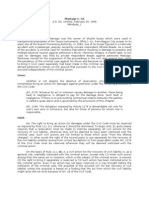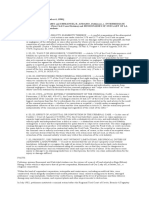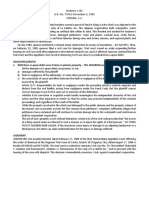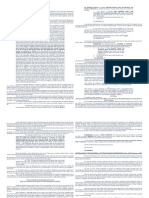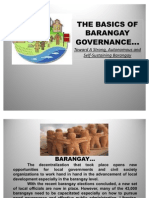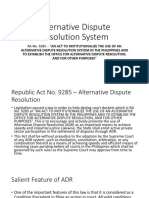0 ratings0% found this document useful (0 votes)
62 viewsAndamo Vs IAC
Andamo Vs IAC
Uploaded by
DanielleThis case discusses a civil suit filed by landowners against a neighboring religious corporation for damages caused by waterpaths and structures built by the corporation on its land. These structures allegedly flooded and eroded the landowners' property. The court had to determine if the civil suit could proceed separately from a related criminal case. The Supreme Court ruled that the civil suit for damages due to negligence could move forward independently under the Civil Code articles on quasi-delicts, as the elements of fault, damages, and causation were present. Even if some of the corporation's actions were potentially criminal, a separate civil case for compensation was allowed pursuant to the Code.
Copyright:
© All Rights Reserved
Available Formats
Download as DOCX, PDF, TXT or read online from Scribd
Andamo Vs IAC
Andamo Vs IAC
Uploaded by
Danielle0 ratings0% found this document useful (0 votes)
62 views1 pageThis case discusses a civil suit filed by landowners against a neighboring religious corporation for damages caused by waterpaths and structures built by the corporation on its land. These structures allegedly flooded and eroded the landowners' property. The court had to determine if the civil suit could proceed separately from a related criminal case. The Supreme Court ruled that the civil suit for damages due to negligence could move forward independently under the Civil Code articles on quasi-delicts, as the elements of fault, damages, and causation were present. Even if some of the corporation's actions were potentially criminal, a separate civil case for compensation was allowed pursuant to the Code.
Original Description:
Torts
Original Title
Andamo vs IAC
Copyright
© © All Rights Reserved
Available Formats
DOCX, PDF, TXT or read online from Scribd
Share this document
Did you find this document useful?
Is this content inappropriate?
This case discusses a civil suit filed by landowners against a neighboring religious corporation for damages caused by waterpaths and structures built by the corporation on its land. These structures allegedly flooded and eroded the landowners' property. The court had to determine if the civil suit could proceed separately from a related criminal case. The Supreme Court ruled that the civil suit for damages due to negligence could move forward independently under the Civil Code articles on quasi-delicts, as the elements of fault, damages, and causation were present. Even if some of the corporation's actions were potentially criminal, a separate civil case for compensation was allowed pursuant to the Code.
Copyright:
© All Rights Reserved
Available Formats
Download as DOCX, PDF, TXT or read online from Scribd
Download as docx, pdf, or txt
0 ratings0% found this document useful (0 votes)
62 views1 pageAndamo Vs IAC
Andamo Vs IAC
Uploaded by
DanielleThis case discusses a civil suit filed by landowners against a neighboring religious corporation for damages caused by waterpaths and structures built by the corporation on its land. These structures allegedly flooded and eroded the landowners' property. The court had to determine if the civil suit could proceed separately from a related criminal case. The Supreme Court ruled that the civil suit for damages due to negligence could move forward independently under the Civil Code articles on quasi-delicts, as the elements of fault, damages, and causation were present. Even if some of the corporation's actions were potentially criminal, a separate civil case for compensation was allowed pursuant to the Code.
Copyright:
© All Rights Reserved
Available Formats
Download as DOCX, PDF, TXT or read online from Scribd
Download as docx, pdf, or txt
You are on page 1of 1
Andamo vs IAC (G.R. No.
74761 November 6, 1990)
Facts: Petitioner spouses Emmanuel and Natividad Andamo are the owners of a parcel of land
situated in Biga (Biluso) Silang, Cavite which is adjacent to that of private respondent,
Missionaries of Our Lady of La Salette, Inc., a religious corporation. Within the land of
respondent corporation, waterpaths and contrivances, including an artificial lake, were
constructed, which allegedly inundated and eroded petitioners' land, caused a young man to
drown, damaged petitioners' crops and plants, washed away costly fences, endangered the
lives of petitioners and their laborers during rainy and stormy seasons, and exposed plants and
other improvements to destruction. As a result there was an institution of a criminal action
against officers and directors of herein respondent corporation and subsequently a civil action
for damages. Due to lack of jurisdiction, the civil case was dismissed due to the criminal case
remaining unresolved following the provision of Section 3 (a), Rule III of the Rules of Court
which provides that "criminal and civil actions arising from the same offense may be instituted
separately, but after the criminal action has been commenced the civil action cannot be
instituted until final judgment has been rendered in the criminal action."
Issue: WON a corporation, which has built through its agents, waterpaths, water conductors and
contrivances within its land, thereby causing inundation and damage to an adjacent land, can be
held civilly liable for damages under Articles 2176 and 2177 of the Civil Code on quasi-delicts
such that the resulting civil case can proceed independently of the criminal case?
Held: Yes. The civil action is one under Articles 2176 and 2177 of the Civil Code on quasidelicts. All the elements of a quasi-delict are present, to wit: (a) damages suffered by the
plaintiff, (b) fault or negligence of the defendant, or some other person for whose acts he must
respond; and (c) the connection of cause and effect between the fault or negligence of the
defendant and the damages incurred by the plaintiff.
The waterpaths and contrivances built by respondent corporation are alleged to have inundated
the land of petitioners. There is therefore, an assertion of a causal connection between the act
of building these waterpaths and the damage sustained by petitioners. Such action if proven
constitutes fault or negligence which may be the basis for the recovery of damages.
Article 2176, whenever it refers to "fault or negligence", covers not only acts "not punishable by
law" but also acts criminal in character, whether intentional and voluntary or negligent.
Consequently, a separate civil action lies against the offender in a criminal act, whether or not
he is criminally prosecuted and found guilty or acquitted, provided that the offended party is not
allowed, (if the tortfeasor is actually charged also criminally), to recover damages on both
scores, and would be entitled in such eventuality only to the bigger award of the two, assuming
the awards made in the two cases vary.
You might also like
- Classifications of PartnershipDocument2 pagesClassifications of PartnershipHonnely Palen-Garzon Aponar-Mahilum100% (4)
- Digest of Maniago v. CA (G.R. No. 104392)Document2 pagesDigest of Maniago v. CA (G.R. No. 104392)Rafael Pangilinan50% (2)
- Andamo Vs Intermediate Appellate CourtDocument8 pagesAndamo Vs Intermediate Appellate CourtSachuzen23No ratings yet
- Andamo CaseDocument3 pagesAndamo CaseCarmela LopezNo ratings yet
- Andamo vs. Iac DigestDocument3 pagesAndamo vs. Iac DigestAr LineNo ratings yet
- Andamo V IACDocument2 pagesAndamo V IACAgz MacalaladNo ratings yet
- Andamo vs. Intermediate Appellate Court, 191 SCRA 195, November 06, 1990Document1 pageAndamo vs. Intermediate Appellate Court, 191 SCRA 195, November 06, 1990Rizchelle Sampang-ManaogNo ratings yet
- Andamo vs. IacDocument1 pageAndamo vs. IacMau ReenNo ratings yet
- ANDAMO vs. IACDocument4 pagesANDAMO vs. IACJocel BatagaNo ratings yet
- Andamo V IAC DigestDocument2 pagesAndamo V IAC DigestJose Ramon Ampil100% (2)
- Andamo vs. IacDocument1 pageAndamo vs. IacZaira Gem GonzalesNo ratings yet
- 189 Andamo V IACDocument12 pages189 Andamo V IACTon RiveraNo ratings yet
- CD - 79. Natividad Andamo Et. Al, Vs.1acDocument1 pageCD - 79. Natividad Andamo Et. Al, Vs.1acMykaNo ratings yet
- TORTSDocument90 pagesTORTSKylie GavinneNo ratings yet
- TORTSDocument90 pagesTORTSChloe SyGalitaNo ratings yet
- Andamo Vs IACDocument3 pagesAndamo Vs IACGeenea VidalNo ratings yet
- Andamano Vs IacDocument2 pagesAndamano Vs IacADNo ratings yet
- Lim Vs BrownelsDocument3 pagesLim Vs BrownelsRoland Ron BantilanNo ratings yet
- Andamo v. IAC & MissionariesDocument2 pagesAndamo v. IAC & MissionariesAaron Ariston100% (2)
- Andamo vs. IACDocument10 pagesAndamo vs. IACJesha GCNo ratings yet
- Torts and Damages: Case Digests - 2 BatchDocument16 pagesTorts and Damages: Case Digests - 2 BatchPaulo Villarin100% (1)
- Torts PorrasDocument4 pagesTorts PorrasWinston AbajeroNo ratings yet
- Prop 12 Andamo Vs IACDocument12 pagesProp 12 Andamo Vs IACchriselskiNo ratings yet
- Torts Full Cases - Batch 2Document44 pagesTorts Full Cases - Batch 2Mari Erika Joi BancualNo ratings yet
- Andamo V IACDocument2 pagesAndamo V IACCzar Ian AgbayaniNo ratings yet
- NIA, Et Al v. IAC, Et AlDocument3 pagesNIA, Et Al v. IAC, Et AlTeresita LunaNo ratings yet
- NIA v. IACDocument1 pageNIA v. IACKaren Joy MasapolNo ratings yet
- Andamao vs. Intermediate Appellate CourtDocument2 pagesAndamao vs. Intermediate Appellate Courtmelinda elnarNo ratings yet
- 1 Andamo Vs IACDocument2 pages1 Andamo Vs IACMelody May Omelan ArguellesNo ratings yet
- Andamo Vs IACDocument6 pagesAndamo Vs IACArmen MagbitangNo ratings yet
- New For Civil LawDocument263 pagesNew For Civil LawReynoldMabaitLayamNo ratings yet
- Andamo V IECDocument8 pagesAndamo V IECMarkKevinAtendidoVidar100% (1)
- Torts and Damages Part 2Document144 pagesTorts and Damages Part 2ConnieAllanaMacapagaoNo ratings yet
- Nia VS IacDocument5 pagesNia VS IacRichmond LucasNo ratings yet
- Virata vs. OchoaDocument3 pagesVirata vs. OchoaBeverlyn JamisonNo ratings yet
- Subject: Topic: Date Made: Digest Maker: CASE NAME: Cinco vs. Hon. Canonoy PONENTE: Melencio-Herrera, J. Case Date: May 31, 1979 Case SummaryDocument4 pagesSubject: Topic: Date Made: Digest Maker: CASE NAME: Cinco vs. Hon. Canonoy PONENTE: Melencio-Herrera, J. Case Date: May 31, 1979 Case SummaryKarina GarciaNo ratings yet
- Barredo vs. Garcia, 73 Phil 607Document10 pagesBarredo vs. Garcia, 73 Phil 607lynne tahilNo ratings yet
- 14 (Pedro Elcano Vs Reginald Hill)Document4 pages14 (Pedro Elcano Vs Reginald Hill)QuiquiNo ratings yet
- Torts Reviewer 2EDocument112 pagesTorts Reviewer 2EMacel Ylagan DacanayNo ratings yet
- Andamo Vs IACDocument4 pagesAndamo Vs IACPam MiraflorNo ratings yet
- Torts Cases - 2nd SetDocument13 pagesTorts Cases - 2nd SetJohn Steve PanchoNo ratings yet
- 9 - (G.R. No. 74761. November 06, 1990)Document6 pages9 - (G.R. No. 74761. November 06, 1990)Lilian FloresNo ratings yet
- Andamo V IAC G.R. No. 74761 November 6, 1990 Fernan, C.J.:: FactsDocument1 pageAndamo V IAC G.R. No. 74761 November 6, 1990 Fernan, C.J.:: FactsAnonymous hS0s2mo100% (1)
- Cinco V Canonoy DigestDocument2 pagesCinco V Canonoy DigestJose Ramon Ampil100% (2)
- Transportation Cases III DDocument6 pagesTransportation Cases III DLiza MarieNo ratings yet
- 1719-TD (43) Supreme Transportation Liner v. San Andres - VICHODocument1 page1719-TD (43) Supreme Transportation Liner v. San Andres - VICHOAnselmo Rodiel IV100% (1)
- Remulla, Estrella & Associates For Petitioners Exequil C. Masangkay For RespondentsDocument3 pagesRemulla, Estrella & Associates For Petitioners Exequil C. Masangkay For RespondentsRob BankyNo ratings yet
- Remulla, Estrella & Associates For Petitioners Exequil C. Masangkay For RespondentsDocument3 pagesRemulla, Estrella & Associates For Petitioners Exequil C. Masangkay For RespondentsBorbankyNo ratings yet
- Edgar Jarantilla V. Court of Appeals and Jose Kuan Sing (Pau) FactsDocument31 pagesEdgar Jarantilla V. Court of Appeals and Jose Kuan Sing (Pau) FactsLhine KiwalanNo ratings yet
- Andamo Vs IacDocument4 pagesAndamo Vs IacRaf RufNo ratings yet
- Civil Law 2 Module 1 Case #008 - Andamo vs. IAC, 191 SCRA 195Document6 pagesCivil Law 2 Module 1 Case #008 - Andamo vs. IAC, 191 SCRA 195Ronald MedinaNo ratings yet
- Case DigestDocument4 pagesCase DigestRoslyn RestorNo ratings yet
- Virata V OchoaDocument1 pageVirata V OchoaJackie CanlasNo ratings yet
- TortsDocument31 pagesTortsMirza Ahad BaigNo ratings yet
- 1 Elcano v. HillDocument8 pages1 Elcano v. HillSusan LazoNo ratings yet
- Candida Virata vs. Victorio OchoaDocument3 pagesCandida Virata vs. Victorio OchoaKristine KristineeeNo ratings yet
- Transpo Cases3 For PrintingDocument15 pagesTranspo Cases3 For PrintingKristoff SimonNo ratings yet
- CAse Doctrines - TortsDocument8 pagesCAse Doctrines - TortsJoseph John Santos RonquilloNo ratings yet
- Torts Virata Vs OchoaDocument2 pagesTorts Virata Vs OchoaNilsaNo ratings yet
- Execution DigestsDocument8 pagesExecution DigestsDanielleNo ratings yet
- Admin List FinalDocument12 pagesAdmin List FinalDanielleNo ratings yet
- PP Vs Wong ChengDocument1 pagePP Vs Wong ChengDanielleNo ratings yet
- Shipside Incorporated+vsDocument4 pagesShipside Incorporated+vsDanielleNo ratings yet
- G.R. No. 135962, March 27, 2000 Metropolitan Manila Development Authority, Petitioner Vs Bel-Air Village Association, Inc., RespondentDocument7 pagesG.R. No. 135962, March 27, 2000 Metropolitan Manila Development Authority, Petitioner Vs Bel-Air Village Association, Inc., RespondentDanielleNo ratings yet
- Santiago Cua, Jr. v. Miguel Ocampo TanDocument22 pagesSantiago Cua, Jr. v. Miguel Ocampo TanDanielleNo ratings yet
- Legal Ethics Canon 14-22Document3 pagesLegal Ethics Canon 14-22DanielleNo ratings yet
- A Fortiori, The Decision or Award of The Voluntary Arbitrator or Panel of Arbitrators ShouldDocument10 pagesA Fortiori, The Decision or Award of The Voluntary Arbitrator or Panel of Arbitrators ShouldDanielle100% (1)
- False Dilemmas Complex Questions Circularity: Fallacies of PresumptionDocument8 pagesFalse Dilemmas Complex Questions Circularity: Fallacies of PresumptionDanielleNo ratings yet
- Motion To Withdraw As CounselDocument3 pagesMotion To Withdraw As CounselDanielleNo ratings yet
- Special Power of AttorneyDocument6 pagesSpecial Power of AttorneyDanielleNo ratings yet
- PNB Vs Rodriguez and PNB Vs Concepcion MiningDocument3 pagesPNB Vs Rodriguez and PNB Vs Concepcion MiningDanielleNo ratings yet
- Civpro 2Document67 pagesCivpro 2DanielleNo ratings yet
- POLIDESDocument7 pagesPOLIDESDanielleNo ratings yet
- Banking Cases 2Document23 pagesBanking Cases 2DanielleNo ratings yet
- Property Outline 7 CasesDocument7 pagesProperty Outline 7 CasesDanielleNo ratings yet
- Leg Res FinalDocument8 pagesLeg Res FinalDanielleNo ratings yet
- Pacioles vs. Chuatoco-Ching DigestDocument2 pagesPacioles vs. Chuatoco-Ching DigestPMV100% (2)
- Labor Law Article - Karen JimenoDocument57 pagesLabor Law Article - Karen JimenoBianca Viel Tombo Caligagan100% (2)
- Vijay Shanker Choube Vs Ram Sewak Kuer and Ors. On 22 August, 2001Document7 pagesVijay Shanker Choube Vs Ram Sewak Kuer and Ors. On 22 August, 2001hhhhhhhuuuuuyyuyyyyyNo ratings yet
- Filinvest vs. Philippine AcetyleneDocument2 pagesFilinvest vs. Philippine AcetyleneRonwell Lim100% (1)
- PNB v. Cedo (1995)Document2 pagesPNB v. Cedo (1995)AbbyElbamboNo ratings yet
- EnactedLaws15thAnd16thCongress PDFDocument83 pagesEnactedLaws15thAnd16thCongress PDFpearlNo ratings yet
- Bharat Aluminium Co V Kaiser Aluminium Technical ServiceDocument190 pagesBharat Aluminium Co V Kaiser Aluminium Technical ServiceBar & BenchNo ratings yet
- Wills - DigestDocument3 pagesWills - DigestMaan MabbunNo ratings yet
- Moral Development ReportDocument11 pagesMoral Development Reportlehsem20006985No ratings yet
- Week 6 - Specific Ethical IssuesDocument6 pagesWeek 6 - Specific Ethical IssuesAmori StudiosNo ratings yet
- United States Court of Appeals, Eleventh CircuitDocument9 pagesUnited States Court of Appeals, Eleventh CircuitScribd Government DocsNo ratings yet
- PALE DigestsDocument14 pagesPALE DigestsAdrian HilarioNo ratings yet
- BFAR Employees Union vs. COADocument5 pagesBFAR Employees Union vs. COARaymondNo ratings yet
- 100 Centre ST Episode ListDocument11 pages100 Centre ST Episode ListMCPyeNo ratings yet
- Manila Terminal Company v. The Court of Industrial Relations - GR No. L-1881.pdf - Case DigestDocument2 pagesManila Terminal Company v. The Court of Industrial Relations - GR No. L-1881.pdf - Case DigestAbigail Tolabing100% (1)
- When Will The Alternative Ob Become A Pure and Simple Obligation (AltenativeDocument4 pagesWhen Will The Alternative Ob Become A Pure and Simple Obligation (AltenativegegegeeNo ratings yet
- Barangay GovernanceDocument143 pagesBarangay GovernanceJonathan86% (21)
- Salient Features of ADRDocument6 pagesSalient Features of ADRWence Ibabao100% (1)
- Consti 2 Sections 14-21Document143 pagesConsti 2 Sections 14-21Mark Kenneth CataquizNo ratings yet
- Republic vs. Elepano Case DigestDocument2 pagesRepublic vs. Elepano Case DigestriaheartsNo ratings yet
- Lakehouse Hotel Job Appointment Offer Letter To Mr. Kumar PradeepDocument2 pagesLakehouse Hotel Job Appointment Offer Letter To Mr. Kumar PradeepPradeep Singh TomarNo ratings yet
- 4 People V BustineraDocument3 pages4 People V BustineraRaymund CallejaNo ratings yet
- PD 1534Document2 pagesPD 1534Marj MendezNo ratings yet
- Passport Application ReceiptDocument3 pagesPassport Application ReceiptAbhay GuptaNo ratings yet
- Review Quiz PerDev (Module 9 - 12)Document2 pagesReview Quiz PerDev (Module 9 - 12)Kelvin IgnacioNo ratings yet
- Notarial WillDocument2 pagesNotarial WillbobbyrickyNo ratings yet
- Evidence CRE MemoDocument14 pagesEvidence CRE MemoAmita SinwarNo ratings yet
- Module 15 For Week 15Document14 pagesModule 15 For Week 15Khianna Kaye PandoroNo ratings yet
- SeebachanDocument11 pagesSeebachanDavid TNo ratings yet

